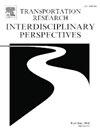How do transportation barriers affect healthcare visits? Using mobile-based trajectory data to inform health equity
IF 3.9
Q2 TRANSPORTATION
Transportation Research Interdisciplinary Perspectives
Pub Date : 2025-02-12
DOI:10.1016/j.trip.2025.101345
引用次数: 0
Abstract
Transportation barriers to healthcare access are a critical issue, leading to unmet healthcare needs for millions of Americans each year, particularly among disadvantaged groups. Understanding and addressing these barriers is thus an important step toward improving health equity. To understand how transportation barriers affect healthcare access, this study first utilized a mobile-based trajectory data to map healthcare visit patterns in the City of Dallas in 2021. Next, a random forest model integrated with spatial analysis techniques was employed to examine the associations of transportation factors and socioeconomic status with healthcare visits. Additionally, to inform health equity decisions, the impact of transportation barriers was compared across racial demographics. Results showed that higher transportation network densities was associated with increased healthcare visits, while higher transit and drive time to healthcare, traffic fatalities, and transport cost burden aligned with decreased healthcare visits. Socio-economic factors including higher Medicaid coverage and higher incomes were positively associated with increased visits. Results also showed that Black-white racial inequities in healthcare visits were amplified by transportation barriers. By introducing mobile-based trajectories for healthcare accessibility analysis, this study contributes to the existing literature by enhancing the understanding and resolution of transportation-related barriers to healthcare access.
求助全文
约1分钟内获得全文
求助全文
来源期刊

Transportation Research Interdisciplinary Perspectives
Engineering-Automotive Engineering
CiteScore
12.90
自引率
0.00%
发文量
185
审稿时长
22 weeks
 求助内容:
求助内容: 应助结果提醒方式:
应助结果提醒方式:


